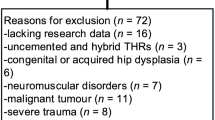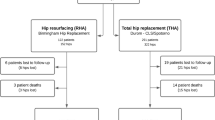Abstract
Background
Preliminary results of metal-on-metal (MoM) hip arthroplasty were satisfactory, but since 2004 data showed high failure rates. National joint replacement registries are multi-centre databases comprised of thousands of subjects and implants which allow for identifying variables predictive of implant failure. The aim of the current study was to estimate re-revision rates after revision of a primary MoM hip arthroplasty in the Dutch Arthroplasty Register (LROI) and to assess potential predictor variables of re-revision of these MoM hip arthroplasties.
Methods
Eligible procedures were those with a revision for any reason except infection, after an initial primary surgery with a hip resurfacing (HRA) or large-head MoM (LH-MoM) total hip arthroplasty (THA). The probability of re-revision for both types of MoM hip arthroplasty over time was estimated using the cumulative incidence function taking mortality as a competing risk into account. A proportional sub-distribution hazards regression model was used to assess potential predictor variables of re-revision of these MoM hip arthroplasties.
Results
A total of 3476 records of revised implants were included, of which 873 (25.2%) were MoM implants. Over the course of follow-up, 101 (11.5%) MoM implants were re-revised. During follow-up 36 (4.3%) patients who received a MoM-implant at primary arthroplasty and a revision afterwards had died. The regression model showed that for primary MoM implants a MoM articulation after revision (HR 2.48; 95% CI 1.53–4.03, p < 0.001), femoral-only revisions (HR 3.20; 95% CI 2.06–4.99, p < 0.001) and periprosthetic fractures (HR 1.98; 95% CI 1.03–3.82, p = 0.042) as reason for the first revision were statistically significant risk factors for re-revision.
Conclusion
Both types of large-head MoM hip arthroplasties have shown high revision and re-revision rates; risk factors were identified. The outcome of this study can be helpful in managing expectations of patients and orthopaedic surgeons.

Similar content being viewed by others
References
Hernigou P (2013) Earliest times before hip arthroplasty: from John Rhea Barton to Themistocles Gluck. Int Orthop 37(11):2313–2318
Corten K, Ganz R, Simon JP, Leunig M (2011) Hip resurfacing arthroplasty: current status and future perspectives. Eur Cell Mater 21:243–258
Schmalzried TP, Fowble VA, Ure KJ, Amstutz HC (1996) Metal on metal surface replacement of the hip technique, fixation, and early results. Clin Orthop Relat Res 329 Suppl:S106–S114
Matharu VK, Matharu GS (2017) Metal-on-metal hip replacements: implications for general practice. Br J Gen Pract 67(665):544–545
Smith AJ, Dieppe P, Howard PW, Blom AW, National Joint Registry for England and Wales (2012) Failure rates of metal-on-metal hip resurfacings: analysis of data from the National Joint Registry for England and Wales. Lancet 380(9855):1759–1766
Smith AJ, Dieppe P, Vernon K, Porter M, Blom AW, National Joint Registry of England and Wales (2012) Failure rates of stemmed metal-on-metal hip replacements: analysis of data from the National Joint Registry of England and Wales. Lancet 379(9822):1199–1204
Verhaar JAN (2012) The hard lesson of metal-on-metal hip implants. Ned Tijdschr Geneeskd 156(42):A5564
van Steenbergen LZ, Denissen GAW, Schreurs BW, Zijlstra WP, Koot HWJ, Nelissen RGHH (2020) Dutch advice not to use large head metal-on-metal hip arthroplasties justifiable—results from the Dutch Arthroplasty Register. Ned Tijdschr Orthop 27(1):4–11
Lübbeke A, Roussos C, Barea C, Köhnlein W, Hoffmeyer P (2012) Revision total hip arthroplasty in patients 80 years or older. J Arthroplasty 27(6):1041–1046
Ong KL, Lau E, Suggs J, Kurtz SM, Manley MT (2010) Risk of subsequent revision after primary and revision total joint arthroplasty. Clin Orthop Relat Res 468(11):3070–3076
Grammatopoulos G, Pandit G, Kwon YM, Gundle R, McLardy-Smith P, Beard DJ, Murray DW, Gill HS (2009) Hip resurfacings revised for inflammatory pseudotumour have a poor outcome. J Bone Jt Surg Br 91(8):1019–1024
Bonner B, Arauz P, Klemt C, Kwon YM (2020) Outcome of re-revision surgery for adverse local tissue reaction in metal-on-polyethylene and metal-on-metal total hip arthroplasty. J Arthroplasty 35(6S):S284–S288
Borton ZM, Mumith AS, Nicholls AJ, Pearce AR, Briant-Evans TW, Griffiths JT (2019) The outcome of revision surgery for failed metal-on-metal total hip arthroplasty. J Arthroplasty 34(8):1749–1754
Vektis (2017) http://www.vektis.nl. Accessed 1 July 2020
Sayers A, Evans JT, Whitehouse MR, Blom AW (2018) Are competing risks models appropriate to describe implant failure? Acta Orthop 89(3):256–258
Fine JP, Gray RJ (1999) A proportional hazards model for the subdistribution of a competing risk. JASA 94:496–509
Wong JM, Liu YL, Graves S, de Steiger R (2015) What is the rerevision rate after revising a hip resurfacing arthroplasty? Analysis from the AOANJRR. Clin Orthop Relat Res 473(11):3458–3464
Matharu GS, Pynsent PB, Sumathi VP, Mittal S, Buckley CD, Dunlop DJ, Revell PA, Revell MP (2014) Predictors of time to revision and clinical outcomes following revision of metal-on-metal hip replacements for adverse reaction to metal debris. Bone Jt J 96-B(12):1600–1609
Matharu GS, Judge A, Pandit HG, Murray DW (2017) Which factors influence the rate of failure following metal-on-metal hip arthroplasty revision surgery performed for adverse reactions to metal debris? An analysis from the National Joint Registry for England and Wales. Bone Jt J 99-B(8):1020–1027
Lainiala O, Reito A, Nieminen J, Eskelinen A (2020) Complications and re-revisions after revisions of 528 metal-on-metal hips because of adverse reactions to metal debris. Acta Orthop 91(4):365–371
van Steenbergen LN, Denissen GAW, Spooren A, van Rooden SM, van Oosterhout FJ, Morrenhof JW, Nelissen RGHH (2015) More than 95% completeness of reported procedures in the population-based Dutch Arthroplasty Register. Acta Orthop 86(4):498–505
LROI, Completeness of registering hospitals and completeness of registered arthroplasties in the LROI baes on the hospital information system in 2018. https://www.lroi-rapportage.nl/data-quality-coverage-and-completeness19. Accessed 1 Sept 2020
Matharu GS, Eskelinen A, Judge A, Pandit HG, Murray DW (2018) Revision surgery of metal-on-metal hip arthroplasties for adverse reactions to metal debris. Acta Orthop 89(3):278–288
Law JI, Crawford DA, Adams JB, Lombardi AV Jr (2020) Metal-on-metal total hip revisions: pearls and pitfalls. J Arthroplasty 35(6S):68–72
Gomes LSM, Roos MV, Takata ET, Schuroff AA, Alves SD, Júnior AC, Miranda RH (2017) Advantages and limitations of national arthroplasty registries. The need for multicenter registries: the Rempro-SBQ. Rev Bras Ortop 52(Suppl 1):3–13
Funding
The authors did not receive support from any organization for the submitted work.
Author information
Authors and Affiliations
Corresponding author
Ethics declarations
Conflict of Interest
All authors certify that they have no affiliations with or involvement in any organization or entity with any financial interest or non-financial interest in the subject matter or materials discussed in this manuscript.
Ethical approval
All data in the LROI are collected in the context of improving quality of care. Therefore, the current study is not required to have an institutional review board approval.
Informed consent
Not applicable.
Additional information
Publisher's Note
Springer Nature remains neutral with regard to jurisdictional claims in published maps and institutional affiliations.
Rights and permissions
About this article
Cite this article
Jelsma, J., van Kuijk, S.M.J., Spekenbrink-Spooren, A. et al. Outcome of revised metal-on-metal hip arthroplasties: a Dutch arthroplasty register study. Arch Orthop Trauma Surg 142, 4025–4032 (2022). https://doi.org/10.1007/s00402-021-04257-5
Received:
Accepted:
Published:
Issue Date:
DOI: https://doi.org/10.1007/s00402-021-04257-5




